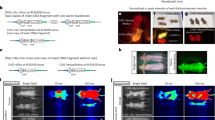Abstract
Firefly luciferase is the most widely used optical reporter for noninvasive bioluminescence imaging (BLI) in rodents. BLI relies on the ability of the injected luciferase substrate D-luciferin to access luciferase-expressing cells and tissues within the animal. Here we show that injection of mice with a synthetic luciferin, CycLuc1, improves BLI with existing luciferase reporters and enables imaging in the brain that could not be achieved with D-luciferin.
This is a preview of subscription content, access via your institution
Access options
Subscribe to this journal
Receive 12 print issues and online access
$259.00 per year
only $21.58 per issue
Buy this article
- Purchase on Springer Link
- Instant access to full article PDF
Prices may be subject to local taxes which are calculated during checkout



Similar content being viewed by others
Change history
13 February 2014
In the version of this article initially published online, the author name Miranda A. Paley was incorrectly spelled as Miranwda A. Paley. The error has been corrected for the print, PDF and HTML versions of this article.
References
Contag, C.H. & Bachmann, M.H. Annu. Rev. Biomed. Eng. 4, 235–260 (2002).
Dothager, R.S. et al. Curr. Opin. Biotechnol. 20, 45–53 (2009).
Prescher, J.A. & Contag, C.H. Curr. Opin. Chem. Biol. 14, 80–89 (2010).
Rabinovich, B.A. et al. Proc. Natl. Acad. Sci. USA 105, 14342–14346 (2008).
Kim, J.-B. et al. PLoS ONE 5, e9364 (2010).
Mezzanotte, L. et al. Mol. Imaging Biol. 12, 406–414 (2010).
Harwood, K.R., Mofford, D.M., Reddy, G.R. & Miller, S.C. Chem. Biol. 18, 1649–1657 (2011).
Shinde, R., Perkins, J. & Contag, C.H. Biochemistry 45, 11103–11112 (2006).
Berger, F., Paulmurugan, R., Bhaumik, S. & Gambhir, S.S. Eur. J. Nucl. Med. Mol. Imaging 35, 2275–2285 (2008).
Kojima, R. et al. Angew. Chem. Int. Edn. Engl. 52, 1175–1179 (2013).
Conley, N.R., Dragulescu-Andrasi, A., Rao, J. & Moerner, W.E. Angew. Chem. Int. Ed. 51, 3350–3353 (2012).
Zhao, H. et al. J. Biomed. Opt. 10, 41210 (2005).
McCutcheon, D.C., Paley, M.A., Steinhardt, R.C. & Prescher, J.A. J. Am. Chem. Soc. 134, 7604–7607 (2012).
Woodroofe, C.C. et al. Biochemistry 51, 9807–9813 (2012).
Reddy, G.R., Thompson, W.C. & Miller, S.C. J. Am. Chem. Soc. 132, 13586–13587 (2010).
Woodroofe, C.C. et al. Biochemistry 47, 10383–10393 (2008).
Cao, Y.-A. et al. Proc. Natl. Acad. Sci. USA 101, 221–226 (2004).
Zhang, H. et al. Mol. Ther. 19, 1440–1448 (2011).
Safran, M. et al. Mol. Imaging 2, 297–302 (2003).
Madisen, L. et al. Nat. Neurosci. 13, 133–140 (2010).
Bäckman, C.M. et al. Genesis 44, 383–390 (2006).
Acknowledgements
This work was supported by grants from the US National Institutes of Health (R01EB013270 to S.C.M. and NS38194 to N.A.), the CHDI (to N.A.), the American Cancer Society (IRG-98-279-07 to J.A.P.) and the University of California, Irvine, School of Physical Sciences (to J.A.P.).
Author information
Authors and Affiliations
Contributions
M.S.E. and J.A.P. imaged tumors and L2G85-FVB mice, G.R.R. synthesized CycLuc1, M.A.P. imaged cultured cells, J.P.C. bred Dat mice, S.T.A. and J.P.C. imaged AAV9 and Dat mice, N.A. contributed to the development of AAV9 and Dat mouse models and manuscript editing, S.C.M. designed CycLuc1, and S.C.M. and J.A.P. led the study and wrote the manuscript.
Corresponding authors
Ethics declarations
Competing interests
The University of Massachusetts Medical School, at which some of the authors are employed, holds patents on luciferin substrates (US7910087 and US8216550), for which the assignee is the University of Massachusetts and the inventor is Stephen C. Miller.
Supplementary information
Supplementary Text and Figures
Supplementary Figures 1–10 (PDF 5299 kb)
Rights and permissions
About this article
Cite this article
Evans, M., Chaurette, J., Adams, S. et al. A synthetic luciferin improves bioluminescence imaging in live mice. Nat Methods 11, 393–395 (2014). https://doi.org/10.1038/nmeth.2839
Received:
Accepted:
Published:
Issue Date:
DOI: https://doi.org/10.1038/nmeth.2839
This article is cited by
-
Development of two mouse strains conditionally expressing bright luciferases with distinct emission spectra as new tools for in vivo imaging
Lab Animal (2023)
-
An optimized bioluminescent substrate for non-invasive imaging in the brain
Nature Chemical Biology (2023)
-
Exploration of biocompatible AIEgens from human trichochrome
Science China Materials (2022)
-
Firefly luciferase offers superior performance to AkaLuc for tracking the fate of administered cell therapies
European Journal of Nuclear Medicine and Molecular Imaging (2022)
-
Portable bioluminescent platform for in vivo monitoring of biological processes in non-transgenic animals
Nature Communications (2021)



